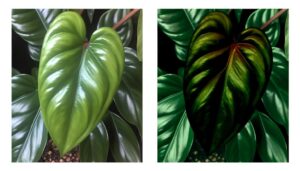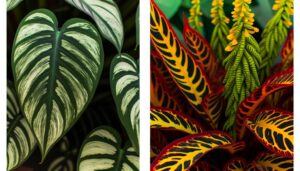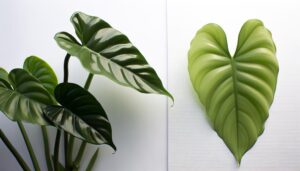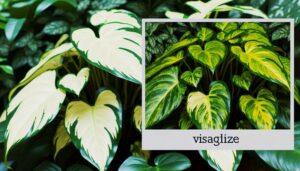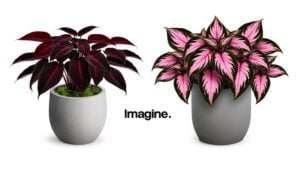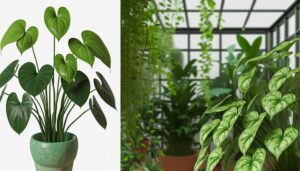Philodendron Hope Vs Shangri La: Key Differences
Philodendron Hope and Philodendron Shangri La, both originating from South American rainforests, exhibit distinct characteristics. Philodendron Hope features larger, deeply lobed leaves, forming an expansive canopy and reaching up to 3 feet in length.
In contrast, Shangri La has more compact, finely dissected foliage with a denser, upright growth habit. Their differing growth patterns make Hope suitable for larger spaces, while Shangri La is ideal for confined areas.
Both prefer bright, indirect light, well-draining soil, and high humidity. Ideal for varying horticultural applications, these philodendrons cater to specific environmental needs.
Learn more about their exclusive care requirements and best uses.
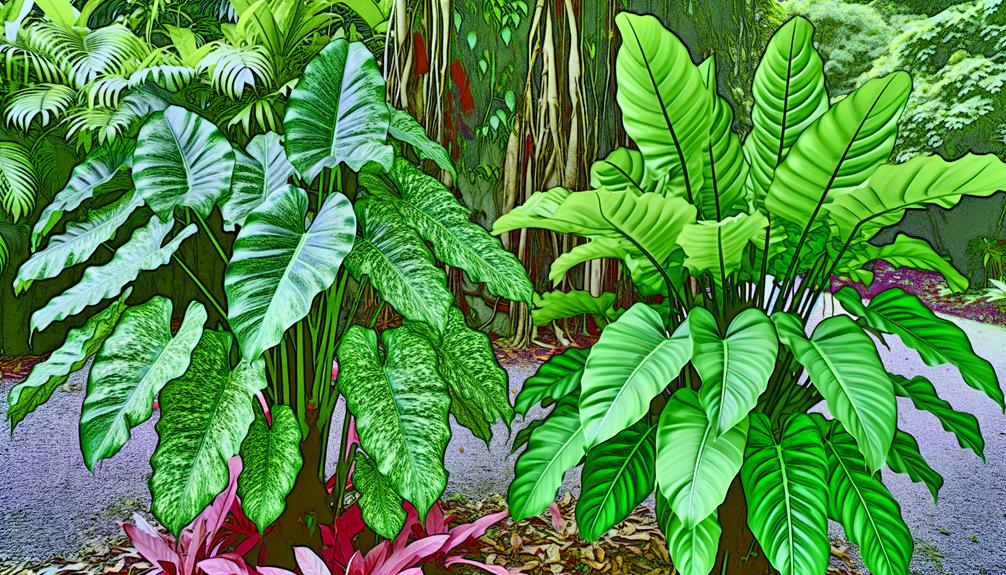
Key Takeaways
- Philodendron Hope features larger, deeply lobed leaves, while Shangri La has smaller, finely dissected foliage.
- Hope grows upright with a tree-like structure, whereas Shangri La forms a compact, bushy clump.
- Philodendron Hope requires bright, indirect light; Shangri La thrives in filtered light.
- Both need well-drained, consistently moist soil but should dry out slightly between waterings.
- Ideal temperature and humidity for both range from 65°F to 80°F and 60% to 80% humidity.
Key Differences Between Philodendron Hope and Philodendron Shangri La
| Feature | Philodendron Hope | Philodendron Shangri La |
|---|---|---|
| Leaf Shape | Large, deeply lobed, almost fern-like | Smaller, ruffled, and more compact |
| Growth Habit | Upright, bushy growth with taller stems | More compact and dense, with shorter stems |
| Size | Can grow up to 5 feet tall with a spread of 5 feet | Typically stays around 2-3 feet tall and wide |
| Light Requirements | Prefers bright, indirect light | Thrives in medium to bright, indirect light |
| Watering Needs | Water when the top 1-2 inches of soil are dry | Water when the top inch of soil is dry |
| Soil Preference | Well-draining potting mix | Prefers well-draining, slightly loamy soil |
| Growth Speed | Moderate to fast growth | Slow to moderate growth |
| Temperature Tolerance | Prefers temperatures between 65-80°F (18-27°C) | Thrives in similar temperatures of 65-80°F (18-27°C) |
| Toxicity | Toxic to pets and humans if ingested | Toxic to pets and humans if ingested |
| Maintenance | Requires occasional pruning of yellow or dead leaves | Low maintenance, occasional pruning for shape |
Origin and History
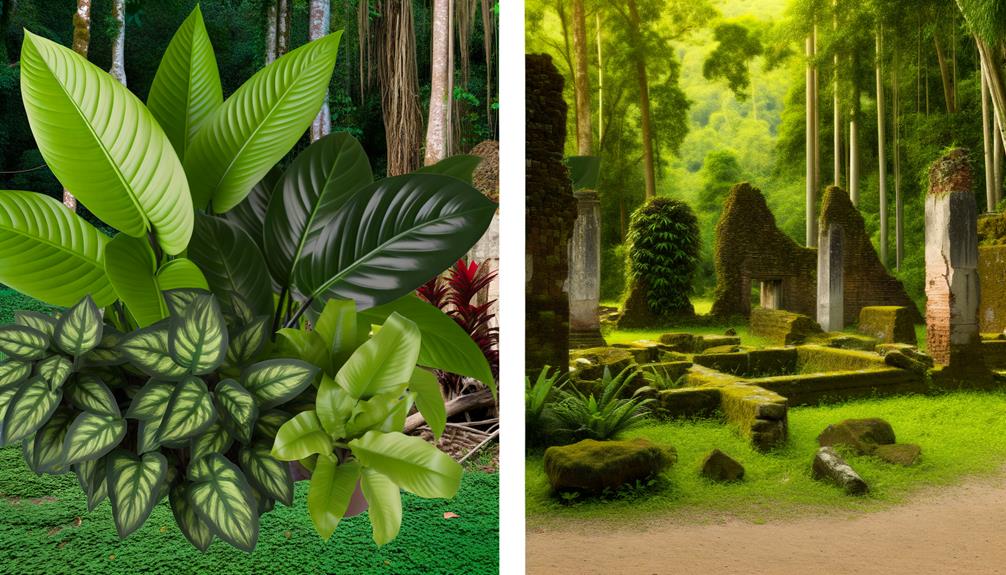
Philodendron Hope, a cultivar of Philodendron bipinnatifidum, and Philodendron Shangri La, a cultivar of Philodendron selloum, both trace their origins to the tropical rainforests of South America, specifically within the regions of Brazil and Paraguay. These regions provide the ideal humid and shaded conditions necessary for their growth.
Philodendron bipinnatifidum and Philodendron selloum belong to the Araceae family, known for their adaptability to low-light environments and their epiphytic nature, enabling them to thrive without soil. Both cultivars were selectively bred to enhance their ornamental qualities, such as increased foliage density and improved resilience.
Their domestication has contributed to their popularity in horticulture, making them highly sought after for indoor and outdoor landscaping worldwide.
Physical Appearance
The physical appearance of Philodendron Hope and Shangri La can be distinguished by their distinct leaf morphology and growth habits. Philodendron Hope exhibits larger, deeply lobed leaves with a more expansive spread, whereas Shangri La features more compact, finely dissected foliage.
Additionally, the structural growth patterns reveal Philodendron Hope’s tendency to form a broader, more open canopy, contrasting with the denser, upright growth habit of Shangri La.
Leaf Shape and Size
With their deeply lobed, glossy green leaves, Hope and Shangri La philodendrons exhibit distinct morphological differences in leaf shape and size.
Philodendron Hope, also known as Philodendron bipinnatifidum, features large, pinnately lobed leaves that can grow up to 3 feet in length and 2 feet in width. These leaves are characterized by their pronounced lobes and deep sinuses.
In contrast, Philodendron Shangri La, a cultivar of Philodendron bipinnatifidum, has more compact foliage, with leaves measuring approximately 1-1.5 feet in length and 0.5-1 feet in width. Shangri La leaves are similarly lobed but exhibit less pronounced sinuses and a slightly more rounded appearance.
These differences are pivotal in distinguishing between the two popular philodendron varieties.
Growth Habit and Structure
Exhibiting distinct growth habits, Hope philodendrons generally develop an upright, tree-like form, while Shangri La philodendrons display a more compact, bushy structure. Hope philodendrons (Philodendron bipinnatifidum) feature robust, woody stems that support large, deeply lobed leaves, creating a commanding vertical presence.
In contrast, Shangri La philodendrons (Philodendron ‘Shangri La’) exhibit a denser growth pattern with shorter internodes, resulting in a fuller, more rounded appearance. The latter’s leaves are smaller, more numerous, and closely spaced, giving it a lush, voluminous look.
This structural divergence influences not only aesthetic appeal but also space utilization, making Hope more suitable for larger spaces and Shangri La ideal for confined areas or as a tabletop plant. Both varieties, however, retain the attractive, tropical foliage characteristic of the Philodendron genus.
Leaf Shape and Size
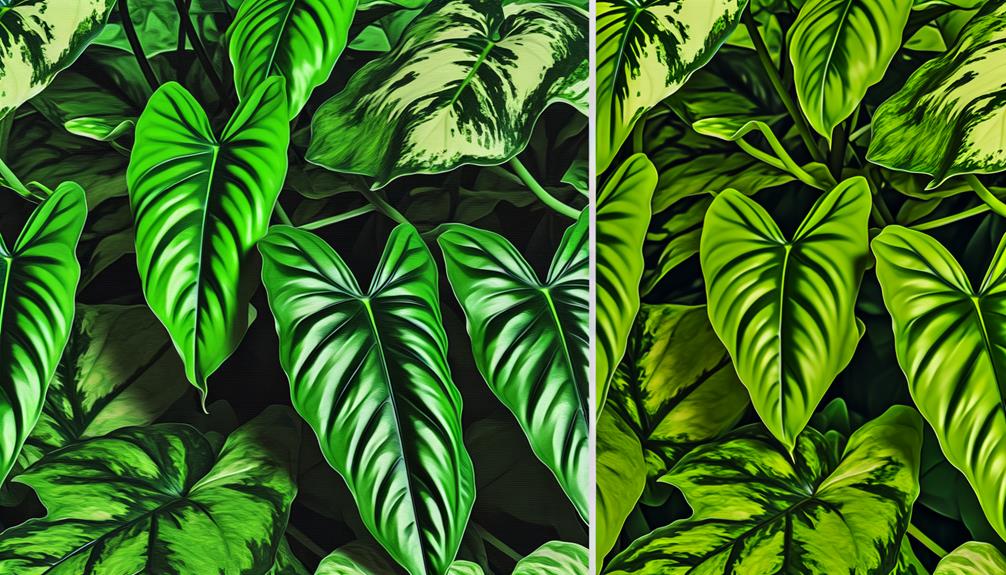
Philodendron Hope presents large, deeply lobed leaves, while Philodendron Shangri La features more compact, finely serrated foliage.
The leaves of Philodendron Hope can reach up to 3 feet in length, characterized by prominent, deep indentations that create an almost finger-like appearance. This species exhibits a lush, expansive leaf structure which enhances its ornamental value.
Conversely, Philodendron Shangri La’s leaves are typically smaller, rarely exceeding 12 inches in length, with a distinctive, finely serrated or crenate margin. The compact nature of Shangri La’s foliage contributes to its dense, bushy aesthetic.
Both species exhibit a vibrant green coloration, but the differences in leaf morphology significantly impact their visual and spatial presentation, making each suitable for different horticultural applications.
Growth Patterns
Regarding growth patterns, Philodendron Hope demonstrates a robust, upright growth habit, often developing into a sizable, tree-like form with a single central stem. This species is characterized by its strong vertical growth, ultimately reaching heights of up to 4 feet indoors. The foliage emerges from a singular stem, radiating outward in a visually striking manner. In contrast, Philodendron Shangri La exhibits a more compact, bush-like growth pattern. It tends to spread horizontally, forming dense clumps of foliage, which makes it suitable for ground cover and container gardening.
| Characteristic | Philodendron Hope | Philodendron Shangri La |
|---|---|---|
| Growth Habit | Upright, tree-like | Compact, bush-like |
| Stem Structure | Single central stem | Multiple stems |
| Height Indoors | Up to 4 feet | Up to 2 feet |
| Spread | Moderate | Extensive |
| Ideal Use | Statement plant | Ground cover, containers |
Light Requirements
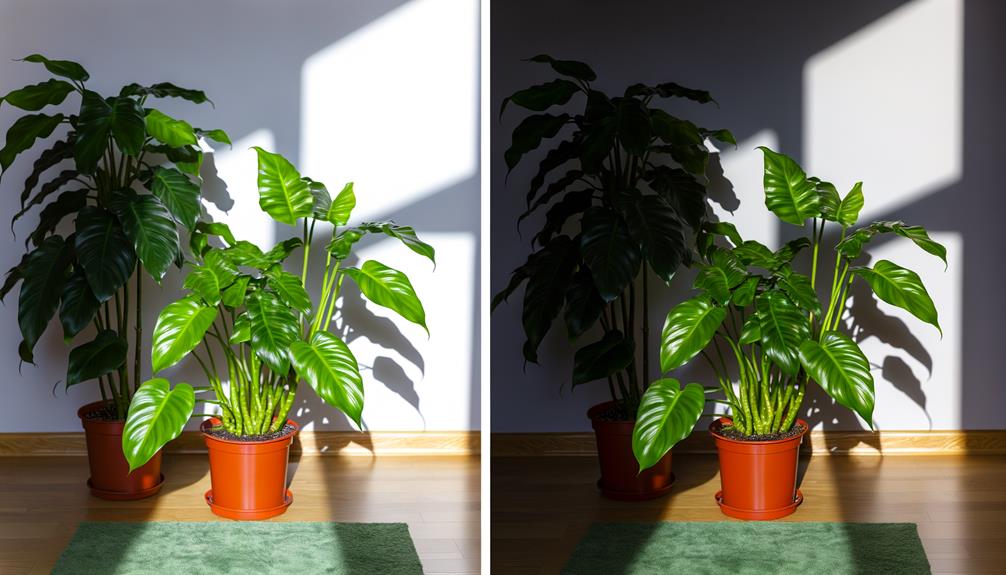
Best light conditions are necessary for the healthy growth of both Philodendron Hope and Philodendron Shangri La, as they greatly influence photosynthetic efficiency and overall plant vitality. Philodendron Hope thrives in bright, indirect light, which promotes optimal chlorophyll production and robust foliage development. Excessive direct sunlight, however, can lead to photoinhibition and chlorosis.
Similarly, Philodendron Shangri La prefers filtered light to mimic its native understory habitat, ensuring sustained photosynthetic activity without the risk of photodamage. Prolonged exposure to low light conditions in either species can result in etiolation, characterized by elongated stems and sparse leaves. Therefore, providing an environment with consistent, diffused light is essential for maintaining the physiological and morphological health of these philodendrons.
Watering Needs
Understanding the watering needs of Philodendron Hope and Shangri La involves examining best watering frequency, maintaining appropriate soil moisture levels, and mitigating overwatering risks.
Both species thrive in well-drained soil that remains consistently moist but not waterlogged, necessitating precise irrigation practices.
Overwatering can result in root rot and other detrimental conditions, emphasizing the importance of careful water management tailored to each plant’s requirements.
Optimal Watering Frequency
To maximize growth and health, the Philodendron Hope and Shangri La require a precise and consistent watering schedule tailored to their specific physiological needs. Best watering frequency hinges on various factors, including ambient temperature, humidity levels, and the plant’s developmental stage.
Generally, both species thrive with moderate moisture, necessitating watering approximately every 7-10 days during the growing season. It is essential to allow the top 1-2 inches of soil to dry out between waterings, preventing root rot and other moisture-related pathologies.
During dormancy, typically in winter months, the watering frequency should be reduced to every 2-3 weeks. Monitoring the plant’s response to watering adjustments is vital for maintaining the best hydration without over-saturating the root system.
Soil Moisture Levels
Maintaining ideal soil moisture levels for Philodendron Hope and Shangri La is crucial, as it directly impacts their physiological health and growth dynamics. Both species thrive in environments where the soil is consistently moist but not waterlogged.
Proper soil moisture management involves:
- Soil Texture: Use well-draining soil mixtures to prevent water stagnation.
- Watering Techniques: Employ deep watering methods to guarantee thorough saturation.
- Moisture Retention: Incorporate organic matter like peat or coco coir to uphold moisture balance.
- Humidity Considerations: High ambient humidity can alleviate rapid soil moisture loss.
- Monitoring: Utilize soil moisture meters to precisely measure hydration levels.
These factors collectively ensure that both Philodendron Hope and Shangri La maintain prime hydration, promoting strong growth and minimizing stress responses.
Overwatering Risks
While maintaining proper soil moisture levels is essential, it is equally important to recognize the risks associated with overwatering, which can lead to root rot and other detrimental conditions in Philodendron Hope and Shangri La. Excessive water disrupts the oxygen supply to the root system, fostering anaerobic conditions favorable for pathogenic fungi such as Pythium and Phytophthora. Symptoms of overwatering include yellowing leaves, wilting despite moist soil, and a foul odor emanating from the root zone.
Both Philodendron Hope and Shangri La require well-draining soil to mitigate these risks. Implementing a watering schedule that allows the top inch of soil to dry out before rewatering can prevent waterlogged conditions and promote best root health.
Soil Preferences
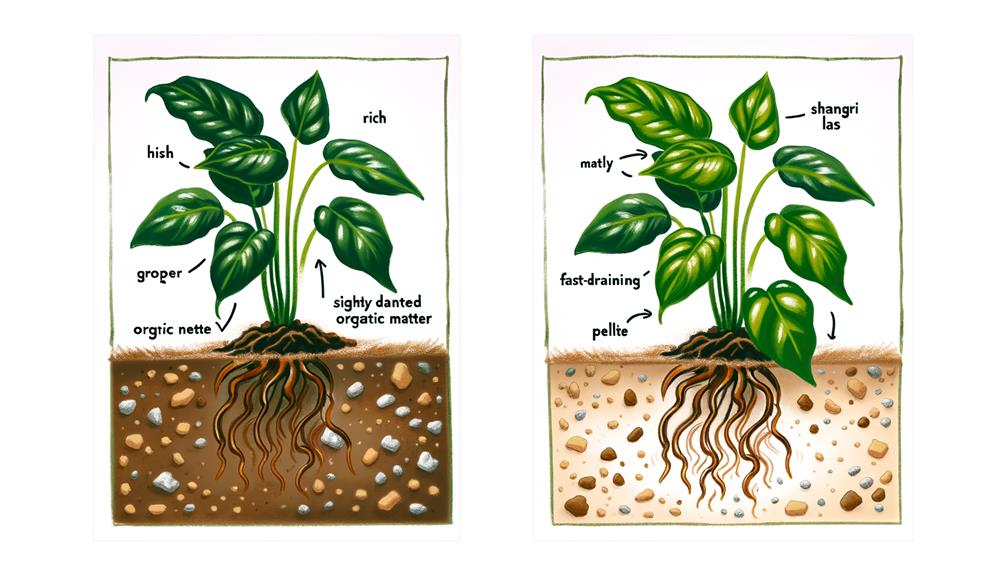
Philodendron Hope and Shangri La flourish best in well-draining, nutrient-rich soil that maintains adequate moisture while preventing waterlogging. An ideal soil mix promotes strong root health and vigorous growth.
Key components for their preferred soil include:
- Organic Matter: Include peat moss or coconut coir to improve moisture retention and aeration.
- Perlite or Pumice: Incorporate these to enhance drainage and prevent soil compaction.
- Compost: Use well-decomposed compost to supply necessary nutrients and boost microbial activity.
- Pine Bark: This aids in increasing aeration and supporting root structure.
- pH Range: Keep a slightly acidic to neutral pH (6.0 to 7.0) to maximize nutrient availability.
These elements collectively establish a favorable environment for the thriving growth of both philodendron varieties.
Temperature and Humidity
Best growth of Philodendron Hope and Shangri La is achieved under specific temperature and humidity conditions that mimic their natural tropical habitat. Ideal temperature ranges from 65°F to 80°F (18°C to 27°C), ensuring robust physiological processes.
Both species thrive in high humidity levels, ideally between 60% and 80%, which facilitates transpiration and nutrient uptake. Insufficient humidity can lead to desiccation and hinder growth.
These plants exhibit sensitivity to temperature fluctuations and cold drafts, often resulting in cellular damage and reduced vigor. Consistency in environmental conditions is crucial, as sudden changes can stress the plants, impairing their resilience.
Employing humidifiers and maintaining stable indoor climates can significantly enhance growth performance and overall health.
Common Pests and Diseases
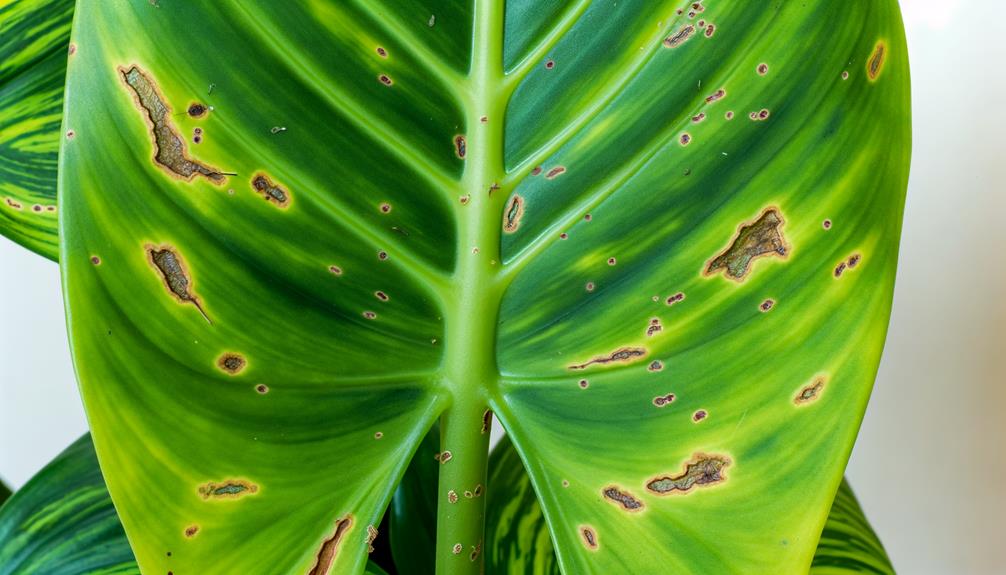
A variety of pests and diseases can afflict Philodendron Hope and Shangri La, compromising their health and aesthetic value. These issues can manifest in various forms, impacting the physiological and morphological aspects of the plants.
Common pests include sap-sucking insects that weaken the plants, while fungal and bacterial pathogens can lead to severe tissue damage. Regular monitoring and appropriate control measures are essential to maintaining plant vigor.
Key concerns include:
- Spider Mites: Cause stippling and webbing on leaves.
- Mealybugs: Produce a cotton-like substance and can cause leaf yellowing.
- Aphids: Lead to distorted new growth and sticky honeydew.
- Bacterial Leaf Spot: Results in water-soaked lesions.
- Root Rot: Caused by overwatering, leading to root decay.
Effective management strategies are necessary for optimal plant health.
Best Uses and Placement
Optimizing the best health of your Philodendron Hope and Shangri La through effective pest and disease management allows for their strategic utilization in enhancing indoor and outdoor spaces.
Philodendron Hope, with its expansive, deeply lobed leaves, thrives in brightly lit areas with indirect sunlight, making it ideal for larger indoor spaces or shaded outdoor areas.
Shangri La, characterized by its compact growth and ruffled leaves, excels in smaller indoor environments, such as offices or bedrooms, where space optimization is essential.
Both species benefit from well-draining soil and consistent, moderate watering. For outdoor placements, ensure partial shade to prevent leaf burn.
These specific environmental conditions and placements maximize the ornamental value and health of Philodendron Hope and Shangri La.
Conclusion
To sum up, the comparison between Philodendron ‘Hope’ and ‘Shangri La‘ unveils clear differences in origin, morphology, and ecological preferences. ‘Hope’ flourishes in moderate light and humidity, whereas ‘Shangri La’ requires higher light levels.
Both display distinct leaf shapes and growth patterns, making them appropriate for specific indoor settings. Grasping these subtleties guarantees ideal cultivation and placement.
Consequently, selecting the appropriate plant is not just a gamble, but a well-informed choice based on scientific knowledge.

